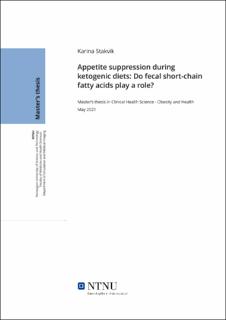| dc.description.abstract | Introduction: Ketogenic diets (KDs) have the ability to suppress the increase in appetite otherwise seen with diet-induced weight loss (WL). The exact mechanisms involved remains unknown, but changes in gut microbiota (GM)/short-chain fatty acids (SCFA) have been suggested as a potential link. Therefore, the main aim of this thesis was to evaluate if changes in fecal SCFA concentrations are associated with appetite suppression during WL induced by a ketogenic low energy diet (LED). A secondary aim was to investigate the impact of WL induced by a ketogenic LED on GM and SCFA.
Method: This study is a longitudinal study with repeated measurements. 83 healthy adults with obesity (BMI: 34.93.5 kg/m2) underwent an 8-week powder-based LED (1000 kcal/day), with a carbohydrate content ranging from 70-130 g/day, followed by a 4-week refeeding and weight stabilization phase. Body weight (BW) and composition, subjective appetite feelings and plasma concentration of appetite hormones (both fasting and postprandial), fasting B-hydroxybutyric acid (BHB) plasma concentration, GM and fecal SCFA were measured at three timepoints (baseline (BL), week 9 (W9) and week 13 (W13)). Data are shown as estimated marginal means SEM.
Results: Participants lost 141.3 kg at W9 (P<0.001) and maintained it at W13. Plasma BHB increased from BL to W9 (0.80.0 mmol/L) and was no longer different from BL at W13. Fasting and postprandial feelings of hunger did not change at W9, but both were higher than BL at W13 (P<0.01, P<0.001, respectively). Basal, but not postprandial AG increased from BL to W9 (P<0.001), and both basal and postprandial AG were higher than BL at W13 (P<0.001, P<0,01, respectively). Alistipes and Ruminococcaceae both increased from BL to W9 (P<0.001, P<0.01, respectively), and Ruminococcaceae decreased from W9 to W13 (P<0.05). Eubacterium rectale decreased from BL to W9 (P<0.001) and increased from W9 to W13 (P<0.001), however the relative composition of this group was lower at W13 compered to BL (P<0.01). Fecal concentration of acetic, propionic and butyric acids decreased from BL to W9 (P<0.001, for all) and increased from W9 to W13 (P<0.05, P<0.01, P<0.001, respectively), but values at W13 were still below BL (P<0.01, for all). The greater the decrease in butyric acid the higher the increase, or smaller the reduction, in basal AG (r=-0.260, P=0.043, n=61) under ketogenic conditions (W9).
Conclusions: This study suggest that WL induced by KD alters GM and SCFA production. However, fecal SCFA do not seem to play a role in the appetite suppression seen under ketogenic conditions. The exact molecular mechanisms mediating appetite suppression under KD remain unknown and more research is clearly needed in this field. | |
